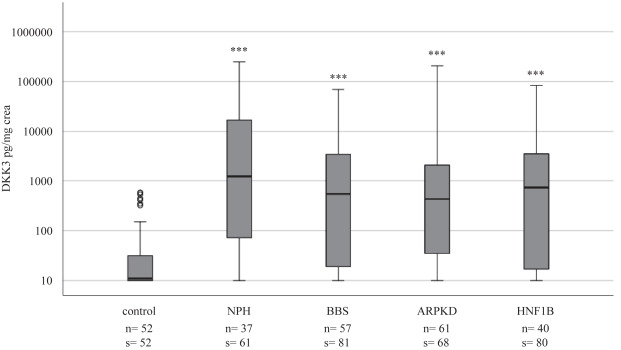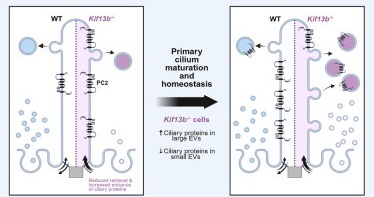News and Publications
Urinary Dickkopf-3 Reflects Disease Severity and Predicts Short-Term Kidney Function Decline in Renal Ciliopathies
Dahmer-Heath et al, Kidney International Reports, Volume 10, Issue 1, p197-208, January 2025. https://www.kireports.org/article/S2468-0249%2824%2901952-1/fulltext
Background
Renal ciliopathies are rare kidney diseases that are difficult to manage because they often show unpredictable symptoms and disease progression. So-called biomarkers are measurable indicators of some biological condition or process in the body that are often used in diagnosis or monitoring disease progression. So far, suitable biomarkers in renal ciliopathies are sparse. A certain protein called Dickkopf-related protein 3 (DKK3) is released by the body in case of kidney damage and can be measured in urine samples. Here, we try to find out if DKK3 could be a helpful marker in the setting of renal ciliopathies.
Methods
We tested urine samples form 195 children with renal ciliopathies for the amount of DKK3. Using this information and other clinical patient data we wanted to find out if DKK3 could serve as a useful indicator (biomarker) for identifying and predicting disease progression.
Results
Patients with renal ciliopathies had much higher level of DKK3 in their urine compared with healthy people. We could see that the stage of chronic kidney disease was linked to DKK3 level (the poorer the kidney function, the higher the level of DKK3 found in their urine). A DKK3 level above 4700 pg/mg was connected with a much faster yearly decline in kidney function.
Conclusion
In renal ciliopathies, DKK3 is a helpful marker to measure how severe the disease is and predict how quickly kidney function might worsen in the near future.
Introduction
Phenotypic heterogeneity and unpredictability of individual disease progression present enormous challenges in ultrarare renal ciliopathies. The tubular-derived glycoprotein, Dickkopf-related protein 3 (DKK3) is a promising biomarker for kidney fibrosis and prediction of kidney function decline. Here, we measured urinary DKK3 (uDKK3) levels in 195 pediatric patients with renal ciliopathy to assess its potential as a discriminative and prediction marker.
Methods
uDKK3 concentration was measured in 357 spot urine samples from 247 individuals, including 52 healthy age-matched controls. Disease entities comprised nephronophthisis (NPH) (n = 37), autosomal recessive polycystic kidney disease (ARPKD) (n = 61), Bardet Biedl syndrome (BBS) (n = 57), and hepatocyte nuclear factor 1 beta (HNF1B)-nephropathy (n = 40). The results were correlated with chronic kidney disease (CKD) stage and annual estimated glomerular filtration rate (eGFR) decline.
Results
Median uDKK3-to-creatinine ratios (uDKK3/crea) in all disease entities were significantly higher compared with healthy controls (11pg/mg uDKK3/crea, P < 0.001): NPH, 1.219 pg/mg; HNF1B, 731 pg/mg; BBS, 541 pg/mg; and ARPKD, 437 pg/mg. A significant correlation of CKD stage with uDKK3 levels was observed for all disease entities (P < 0.0001) with no other clinical parameter having a relevant impact. In our cohort, uDKK3 values >4.700 pg/mg were associated with a significantly greater annual eGFR loss independently of diagnosis and eGFR (P = 0.0029). Although we observed a trend toward lower uDKK3 levels in glomerulopathies compared to renal ciliopathies, there was no discriminative difference between individual ciliopathy entities (P = 0.2637).
Conclusion
In renal ciliopathies, uDKK3 is a marker to assess disease severity and estimate short-term kidney function decline.





